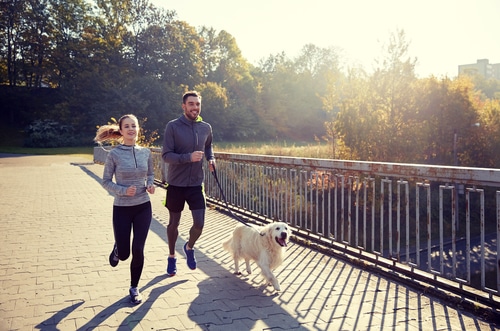Studies have shown that working out with a partner increases motivation and the likelihood of sticking to a training routine. Dogs make great running companions since they are always up for it and have endless supplies of energy to keep up.
However, you can’t expect that everything goes smoothly the first time, and without some training and preparation you will end up chasing after your dog. It is essential to teach a dog to respond to cues and run beside you opposed to pulling you or dragging along.
Are you wondering how to run with your dog the right way and have a great time? Follow these tips to transform your pup into the best running partner.
Preparation & training
If you don’t spend some time teaching your pup to run by your side, you will end up tangled in a leash or dragged across pavement. First of all, you’ll need to teach your dog to walk beside you during your regular walks.
Pack a handful of dry dog food or treats to serve as rewards and reinforce good behavior. Get your dog to sit by your side, give him several treats, and start walking at a brisk pace.
If your pup is walking by your side reward him periodically and keep going. However, if he starts to pull or wants to sniff around get him to stop and sit.
Leave him like that until he focuses his attention on you and then continue walking. Every time your dog gets distracted correct his behavior, and if he behaves nice reward him.
Over time the dog will learn that pulling and sniffing around results in a stop and walking by your side results in a reward and he will start to listen and follow your cues.
Know your breed
All dogs love to run but some are better at it than others. Working dogs like Border Collies, German Shepherds, Huskies, and Retrievers can run for miles without any signs of exhaustion.
Smaller breeds can also be great running companions with the exception of brachycephalic breeds that have trouble breathing and are at higher risk of heat stroke.
It isn’t safe for Pugs and Bulldogs to run, however, so a power walk is also a great way to be fit and keep these dogs in optimal health.
Have your dog checked
Running is a strenuous exercise that puts strain on both muscles and joints so vets recommend it only for dogs that are over 1 year old. However, since large and giant breeds mature later you should check with your vet and have him clear your pooch for running.
It is recommended for people to have their health checked before they start any new training program, and the same applies to dogs. Your vet will look for any underlying issue, and pay close attention to heart, lungs, and joints before he clears your pup fit for running.
Pick the right gear
When it comes to running you should keep things light for your dog. Don’t add up unnecessary weight that will put more strain on his joints. Instead of attaching him to a collar get a harness that won’t obstruct his air flow.
When running with a dog it is best to stay away from retractable leashes and stick with one that is 4-6 foot long. If you want to run with your hands-free, you can choose a leash that wraps around your waist or a cross body leash.
We advise to only use these if you are confident that your pooch won’t pull and end up knocking you on the ground.
Keep your dog hydrated
Since dogs have limited number of sweat glands they are at higher risk of a heat stroke when they are running. If you plan to run more than 1-2 miles you will have to bring enough water for you and your pooch.
Excessive panting, dark red tongue, and pale gums are signs that your dog needs a break and plenty of water. If a dog looks tired and falls behind your pace, find a shade to rest, keep him hydrated and call it a day. Avoid running during the hottest part of the day, let your dog set the pace, and protect his paw pads with a balm or doggy boots.
Conclusion
Running is a great way to keep a dog active and at the same time work on your fitness abilities. Even though all dogs love to run, some breeds aren’t physically capable of this type of exertion.




No Comment